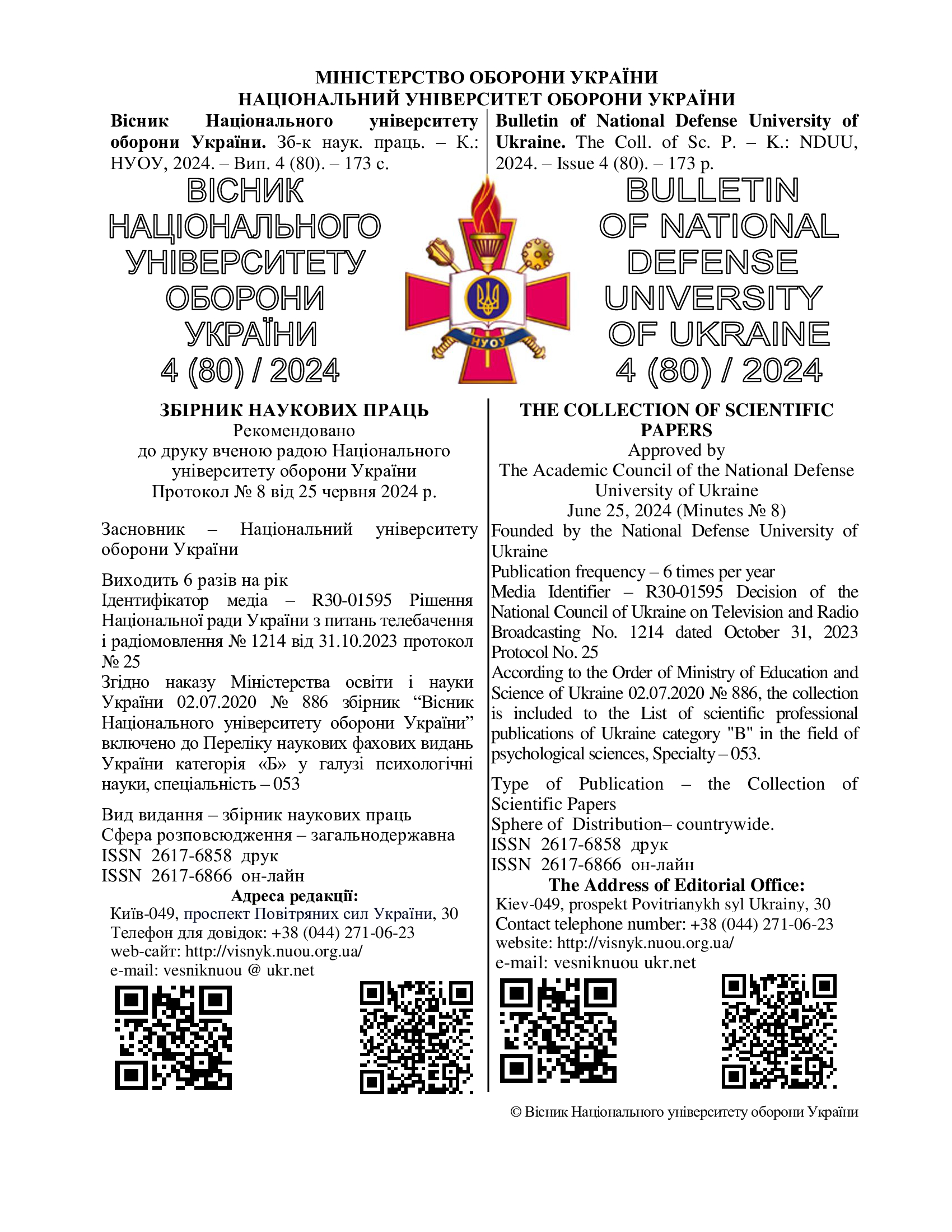АНАЛІТИЧНИЙ ОГЛЯД ПРОБЛЕМИ КОМУНІКАТИВНІ ВЗАЄМОДІЇ У ПСИХОЛОГІЇ: ЗАРУБІЖНИЙ ДИСКУРС
DOI:
https://doi.org/10.33099/2617-6858-2024-80-4-42-46Ключові слова:
комунікативна взаємодія, зарубіжна психологія, методи експериментальних нейронаук, феномен, експериментальні підходи.Анотація
У статті представлено аналітичний огляд проблеми комунікативної взаємодії у зарубіжній психології. Зазначається, що у дослідженнях комунікативних взаємодій за допомогою методів експериментальних нейронаук акумульовано велике розмаїття феноменів, проте основні положення концепцій, що їх описують, нерідко вступають у суперечності між собою. На цей час здійснено чимало досліджень, виконаних у межах різних експериментальних підходів.
Завантаження
Посилання
Anderson, N., Bischof, W., Laidlaw, W., Risko, E. Kingstone, A. (2013) Recurrence quantification analysis of eye movements. Behavior research methods. Vol. 45. №3. P. 842-856. DOI 10.3758/s13428-012- 0299-5
Botvinick, M., Ritter, S., Wang, J., Kurth-Nelson, Z., Blundell, C., Hassabis, D. (2019) Reinforcement learning, fast and slow. Trends in Cognitive Sciences. Vol. 23. №5. P. 408-422. DOI /10.1016/j.tics.2019.02.006
Cichy, R., Kaiser, D. (2019) Deep neural networks as scientific models. Trends in Cognitive Sciences. Vol. 23. №4. P. 305-317. DOI 10.1016/j.tics.2019.01.009
García, A., Ibáñez, A. (2014) Two-person neuroscience and naturalistic social communication: the role of language and linguistic variables in brain-coupling research. Frontiers in psychiatry. Vol. 5.P. 124. DOI 10.3389/fpsyt.2014.00124
Golland, Y., Arzouan, Y., Levit-Binnun, N. (2015) The mere co-presence: synchronization of autonomic signals and emotional responses across co-present individuals not engaged in direct interaction. PLoS ONE. Vol. 10. №5. P. e0125804. DOI 10.1371/journal.pone.0125804.g001
Gunkel, D.J. (2016) Computational interpersonal communication: communication studies and spoken dialogue systems. Communication+1. Vol. 5. №1. P. 1-20. DOI 10.7275/R5VH5KSQ
Hari, R., Himberg, T., Nummenmaa, L., Hämäläinen, M., Parkkonen, L. (2013) Synchrony of brains and bodies during implicit interpersonal interaction. Trends in cognitive sciences. Vol. 17. №3. P. 105-106. DOI 10.1016/j.tics.2013.01.003
Liu, D., Liu, Sh., Liu, X., Zhang, Ch., Li, A., Jin, Ch., Chen, Y., Wang, H., Zhang, X. (2018) Interactive brain activity: review and progress on EEG-based hyperscanning in social interactions. Frontiers in psychology. Vol. 9. P.1862. DOI 10.3389/fpsyg.2018.01862
Lyyra, P., Myllyneva, A., Hietanen, J.K. (2018) Mentalizing eye contact with a face on a video: gaze direction does not influence autonomic arousal. Scandinavian journal of psychology. Vol. 59. №4. P. 360-367. DOI 10.1111/sjop.12452
Macdonald, R.G., Tatler, B.W. (2018) Gaze in a real-world social interaction: a dual eye-tracking study. Quarterly Journal of Experimental Psychology. Vol. 71. №10. P. 2162-2173. DOI 10.1177/1747021817739221
Nummenmaa, L., Glerean, E., Viinikainen, M., Jääskeläinen, I.P., Hari, R., Sams, M. (2012) Emotions promote social interaction by synchronizing brain activity across individuals. Proceedings of the National Academy of Sciences. Vol. 109. №.24. P. 9599-9604. DOI 10.1073/pnas.1206095109
Pfeiffer, U.J., Vogeley, K., Schilbach, L. (2013) From gaze cueing to dual eye-tracking: novel approaches to investigate the neural correlates of gaze in social interaction. Neuroscience and Biobehavioral Reviews. Vol. 37. №10. P. 2516-2528. DOI 10.1016/j.neubiorev.2013.07.017
Privitera, C.M., Stark, L.W. (2005) Scanpath Theory, attention, and image processing algorithms for predicting human eye fixations. Neurobiology of Attention. P. 296-299. DOI 10.1016/B978-012375731- 9/50052-5.
Redcay, E., Schilbach, L. (2019) Using second-person neuroscience to elucidate the mechanisms of social interaction. Nature Reviews Neuroscience. Vol. 20. №8. P. 495-505. DOI 10.1038/s41583-019-0179-4
Rogers, S.L., Speelman, C.P., Guidetti, O., Longmuir, M. (2018) Using dual eye tracking to uncover personal gaze patterns during social interaction. Scientific reports. Vol. 8. №1. P. 1-9. DOI 10.1038/s41598- 018-22726-7
Rubo, M., Gamer, M. (2018) Social content and emotional valence modulate gaze fixations in dynamic scenes. Scientific reports. Vol. 8. №1. P. 1-11. DOI 10.1038/s41598-018-22127-w
Scheller, E., Büchel, C., Gamer, M. (2012) Diagnostic features of emotional expressions are processed preferentially. PLoS ONE. Vol. 7. №7. e41792. DOI 10.1371/journal.pone.0041792
Schilbach, L., Timmermans, B., Reddy, V., Costall, A., Bente, G., Schlicht, T., Vogeley, K. (2013) Toward a second- person neuroscience. Behavioral and brain sciences. Vol. 36. №4. P. 393-414. DOI 10.1017/ S0140525X12000660
Smith, T.J., Mital, P.K. (2013) Attentional synchrony and the influence of viewing task on gaze behavior in static and dynamic scenes. Journal of vision. Vol. 13. №8. P. 16. DOI 10.1167/13.8.16
Yarbus, A.L. (1967) Eye movements and vision. Springer, Boston, MA, С. 171-211. DOI 10.1007/978- 1-4899-5379-7
Yun, K., Watanabe, K., Shimojo, Sh. (2012) Interpersonal body and neural synchronization as a marker of implicit social interaction. Scientific reports. Vol. 2. P. 959. DOI 10.1038/srep00959
Zhang, D., Yao, L., Zhang, X, Wang, S., Chen, W., Boots, R. (2018) Cascade and parallel convolutional recurrent neural networks on eeg-based intention recognition for brain computer interface. AAAI. P. 1703-1710. DOI https://doi.org/10.48550/arXiv.1708.06578
##submission.downloads##
Опубліковано
Як цитувати
Номер
Розділ
Ліцензія
Авторське право (c) 2024 Вісник Національного університету оборони України

Ця робота ліцензується відповідно до Creative Commons Attribution-NonCommercial-ShareAlike 4.0 International License.





